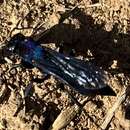Comprehensive Description
(
الإنجليزية
)
المقدمة من Memoirs of the American Entomological Society
Psorthaspis planata (Fox)
Planiceps planatus Fox, 1892, Ent. News, 3: 171 [Type: 9, California: San
Diego (F. E. Blaisdell) (ANSP)]. Pompilus aequus Fox, 1894, Proc. Calif. Acad. Sci., (2)4: 99 [Type: 9,
Mexico: Baja California: El Taste (CAS)]. Synonym by Bradley, 1944.
Pompilus (Pedinaspis) planatus Fox, 1897, Ent. News, 8: 33.
Parapompilus planatus Davidson, 1905, Ent. News, 16: 233 (biology).
Pedinaspis {Pedinaspis) planatus Banks, 1912, Jour. N. Y. Ent. Soc., 19: 231.
Sophropompilus tumifrons Banks, 1917, Bull. Mus. Comp. Zool., 61: 103 [Type: S, California: San Diego Co. (E. P. Van Duzee) (MCZ, no. 10, 016)]. — Banks, 1919, Bull. Mus. Comp. Zool., 63: 238. Synonym by Bradley, 1944.
Psorthaspis planatus Banks, 1919, ibid., p. 241. — Bradley, 1944, Trans. Amer. Ent. Soc., 70: 52-54. — Evans, 1954, Amer. Mus. Nov., no. 1662, p. 12.
Pedinaspis bucephala Malloch, 1928, Proc. Ent. Soc. Wash., 30: 101 [Type: <5 , California: Palm Springs, 9 Aug. 1917 (E. G. Holt) (USNM, no. 27, 431)]. Synonym by Bradley, 1944.
Pedinaspis albocaudata Malloch, 1928, ibid., p. 101 [Type: S, Arizona: Higley, 27 June 1917 (E. G. Holt) (USNM, no. 27, 432)]. Synonym by Evans, 1958, Ent. News, 69: 148-149.
Pedinaspis planatus Jenks, 1938, Nat. Geogr. Mag., 74: 807-828 (biology).
Allocyphonyx albocaudatus Bradley, 1944, Trans. Amer. Ent. Soc, 70: 152.
Psorthaspis morosa Bradley, 1944, ibid., p. 42 [Type: 2, Utah (USNM, no. 57, 923)]. Synonym by Evans, 1954.
As the long synonymy suggests, this is a highly variable species. It is a reasonably common species within its somewhat restricted range, and might provide a worthwhile subject for a detailed study of variation. Males from Arizona and from east of the coast ranges in southern California have a large amount of whitish pubescence on the apex of the abdomen {albocaudata Malloch). It is possible that this represents an introgression of genes from the closely related species portiae. Baja California females have the head unusually thin and broad and the claws more strongly dentate and with the outer ray more strongly curved (aequus Fox). I question whether these differences are sufficiently clear-cut to justify the use of subspecific names, but further study is clearly desirable.
Female. — Length 9-22 mm. Black, pubescence bluish or violaceous, often with some greenish-blue reflections; Baja California specimens generally with the pubescence of the front of the head pale, grayish or somewhat silvery; wings fuscous, violaceous. Front and thoracic dorsum with the erect hair short and relatively sparse; propodeum and femora not or barely hairy. Clypeus flat, its apical margin weakly rounded. Clypeo-frontal bridge broad, on same plane as clypeus and front, its flat top nearly or fully as wide as an antennal socket. Eyes diverging above, UID about 1.1 X LID; vertex extended somewhat above eye tops, extending straight across or slightly concave in the middle; distance from posterior ocelli to vertex crest equal to about 1.5 (1.3-1.8) X POL. Propodeum with strong transverse rugae and with a strongly defined, slightly concave declivity. Hind tibiae with several spines above. Claws dentate, Baja California specimens with the claws rather strongly curved and the tooth strong, almost as in laevifrons, bradleyi, and their allies. Abdomen weakly compressed apically.
Male. — Length 8-13 mm. Black, pubescence extensively bluish or somewhat violaceous, often entirely so, but specimens from southern parts of the range often with silvery pubescence on the lower front and temples, specimens from Arizona and southeastern California also with silvery pubescence on the posterior margin of the pronotum and on the apical abdominal tergites (in some Baja California specimens the pubescence of the apical tergite is grayish or somewhat silvery); wings fuscous, violaceous. Front with rather dense, short setae, but body setae otherwise short and sparse except more numerous toward tip of abdomen. Clypeus rounded below. Antennae of moderate, rather variable length; segments 4-12 each from 1.25-1.7 X as long as thick. Eyes strongly diverging above; upper front rather strongly convex; vertex much elevated above eye tops and weakly to strongly humped in the ocellar triangle, which is very broad and flat. Propodeum elongate, with a short, concave declivity on the sides of which it is rather strongly produced backward. Claws bifid, inner ray acute or subacute, except inner claws of front tarsi with inner ray rounded, lobe-like. SGP tapering to a subacute apex, its median ridge strong, arched in profile; sides dentate well before apex. Genitalia not differing notably from those of other species of the genus, the parameres short, truncate, not swollen apically.
Distribution. — Central California and Utah to Arizona and Baja California. (Map 19.)
Mexican specimens examined. — 11 22, 12 8 8 . Baja California: 1 <?, 20 mi. N Mesquital, 27 Sept. 1941 (ESR & GEB) [CAS]; 1 2 , Isla Partida, Gulf of Calif., 23 Mch. 1953 (P. H. Arnaud) [CAS]; 2 8 8, Cedros Island, 3 June 1925 (H. H. Keifer) [CAS]; 1 2, 3 mi. NW Miraflores, 19 Jan. 1959 (HBL) [CAS]; 1 2, El Taste [CAS]; 6 2 2,6 8 8 , La Paz, 10-12 Oct. 1954 (FXW) [CAS]; 2 2 2,3 8 8 , 25 mi. W La Paz, 4 Sept. 1959 (Radford & Werner) [UA].
- الاقتباس الببليوغرافي
- Evans, H.E. 1966. A Revision of the Mexican and Central American Spider Wasps of the Subfamily Pompilinae (Hymenoptera: Pompilidae). Memoirs of the American Entomological Society vol. 20. Philadelphia, USA

